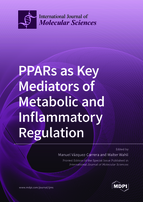PPARs as Key Mediators of Metabolic and Inflammatory Regulation
A special issue of International Journal of Molecular Sciences (ISSN 1422-0067). This special issue belongs to the section "Biochemistry".
Deadline for manuscript submissions: closed (31 December 2021) | Viewed by 97511
Special Issue Editors
2. Spanish Biomedical Research Center in Diabetes and Associated Metabolic Diseases (CIBERDEM)-Instituto de Salud Carlos III, Barcelona, Spain
3. Pediatric Research Institute-Hospital Sant Joan de Déu, Esplugues de Llobregat, Barcelona, Spain
Interests: insulin resistance; PPAR; FGF21; GDF-15; inflammation; type 2 diabetes mellitus; non-alcoholic fatty liver disease (NAFLD) and non-alcoholic steatohepatitis (NASH); atherogenic dyslipidemia; diabetic cardiomyopathy; skeletal muscle
Special Issues, Collections and Topics in MDPI journals
2. Center for Integrative Genomics, University of Lausanne, CH-1015 Lausanne, Switzerland
Interests: nuclear receptor superfamily; gene regulation and gene expression profiling; metabolic regulations; development; skin and wound healing; cancer; liver physiology; non-alcoholic fatty liver disease (NAFLD) and non-alcoholic steatohepatitis (NASH); adipose tissue; muscle and exercise; gut; microbiota; inter-organ cross-talk; nutrition; nutrigenetics and nutrigenomics
Special Issues, Collections and Topics in MDPI journals
Special Issue Information
Dear Colleagues,
Mounting evidence suggests a bidirectional relationship between metabolism and inflammation. Molecular crosstalk between these processes occurs at different levels with the participation of nuclear receptors, including peroxisome proliferator-activated receptors (PPARs). There are three PPAR isotypes α, β/δ, and γ, which modulate metabolic and inflammatory pathways, making them key for the control of cellular, organ, and systemic processes. PPAR activity is governed by fatty acids and fatty acid derivatives, and by drugs used in the clinics (glitazones and fibrates). The study of PPAR action, also modulated by posttranslational modifications, has enabled extraordinary advances in the understanding of the multifaceted roles of these receptors in metabolism, energy homeostasis, and inflammation both in health and disease. This Special Issue of IJMS welcomes a broad range of basic and translational original and review articles focused on the latest developments in the regulation of metabolic and/or inflammatory processes by PPARs in all organs and the microbiome of different vertebrate species.
Prof. Dr. Manuel Vázquez-Carrera
Prof. Dr. Walter Wahli
Guest Editors
Manuscript Submission Information
Manuscripts should be submitted online at www.mdpi.com by registering and logging in to this website. Once you are registered, click here to go to the submission form. Manuscripts can be submitted until the deadline. All submissions that pass pre-check are peer-reviewed. Accepted papers will be published continuously in the journal (as soon as accepted) and will be listed together on the special issue website. Research articles, review articles as well as short communications are invited. For planned papers, a title and short abstract (about 100 words) can be sent to the Editorial Office for announcement on this website.
Submitted manuscripts should not have been published previously, nor be under consideration for publication elsewhere (except conference proceedings papers). All manuscripts are thoroughly refereed through a single-blind peer-review process. A guide for authors and other relevant information for submission of manuscripts is available on the Instructions for Authors page. International Journal of Molecular Sciences is an international peer-reviewed open access semimonthly journal published by MDPI.
Please visit the Instructions for Authors page before submitting a manuscript. There is an Article Processing Charge (APC) for publication in this open access journal. For details about the APC please see here. Submitted papers should be well formatted and use good English. Authors may use MDPI's English editing service prior to publication or during author revisions.
Keywords
- Peroxisome proliferator-activated receptors (PPARs)
- Organ crosstalk
- Energy homeostasis
- Lipids and carbohydrates
- Metabolic regulations
- Metabolic diseases
- Regulation of inflammation
- Inflammation and immunity
- Meta-inflammation
- Inflammatory diseases
- Metabolic endotoxemia
- Metabolic reprogramming and inflammation
- Systems biology
- Host–microbiota crosstalk








